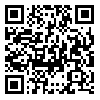Volume 12, Issue 4 (July & August 2021)
BCN 2021, 12(4): 477-488 |
Back to browse issues page
Download citation:
BibTeX | RIS | EndNote | Medlars | ProCite | Reference Manager | RefWorks
Send citation to:



BibTeX | RIS | EndNote | Medlars | ProCite | Reference Manager | RefWorks
Send citation to:
Modarres Zadeh A, Mehri A, Jalaei S, Khatoonabadi A R, Kalbe E. Translation and Cross-cultural Adaptation of the Aphasia Check List in Persian Speakers With Aphasia. BCN 2021; 12 (4) :477-488
URL: http://bcn.iums.ac.ir/article-1-1534-en.html
URL: http://bcn.iums.ac.ir/article-1-1534-en.html
Translation and Cross-cultural Adaptation of the Aphasia Check List in Persian Speakers With Aphasia
1- Department of Speech and Language Pathology, School of Rehabilitation Sciences, Tehran University of Medical Sciences, Tehran, Iran.
2- Department of Physical Sciences, School of Rehabilitation Sciences, Tehran University of Medical Sciences, Tehran, Iran.
3- Medizinische Psychologie Neuropsychologie und Gender Studies, Centrum Für Neuropsychologische Diagnostik und Intervention (CeNDI), Prodekanin Für Akademische Entwicklung and Gender, Köln, Germany.
2- Department of Physical Sciences, School of Rehabilitation Sciences, Tehran University of Medical Sciences, Tehran, Iran.
3- Medizinische Psychologie Neuropsychologie und Gender Studies, Centrum Für Neuropsychologische Diagnostik und Intervention (CeNDI), Prodekanin Für Akademische Entwicklung and Gender, Köln, Germany.
Abstract:
Introduction: The Aphasia Check List (ACL) is a comprehensive, time-saving tool for language evaluation in aphasia, including a cognitive assessment part. This cross-sectional study aimed to translate ACL into Persian and analyze the psychometric features of the translated version. The original version of the ACL was translated and adapted from German; its psychometric features were then determined.
Methods: Twenty People With Aphasia (PWA) and 50 age- and education-matched, cognitively healthy controls participated in this research. Possible floor and ceiling effects, discriminant validity, test-retest reliability, and internal consistency of the test were analyzed in addition to the evaluation of internal correlations between the test parts (language & cognition).
Results: Regarding the performance of PWAs in the language section and the cognitive subtests assessing attention, memory, and reasoning, there were no floor and ceiling effects. Adequate discriminant validities for the language section of the test [i.e., total score: (Mann-Whitney U= 6.000, P<0.001); diagnostic subtests scores: (Mann-Whitney U= 3.000, P<0.001), and each subtest individually. Besides, the attention subtest of the cognition section (Mann-Whitney U= 16.500, P<0.001) was also observed. There was no difference between the control and patient groups in the subtests of memory (Mann-Whitney U= 497.500, P=0.973) and reasoning (Mann-Whitney U= 3.000, P= 308). The test-retest reliability was acceptable in all subtests (ICC agreement= 0.573-0.984). The ACL-P suggested appropriate internal consistency (Cronbach’s alpha coefficient= 0.761 for test & retest scores). There were also significant correlations between language and cognition in the control and patient groups.
Conclusion: The ACL-P test indicated sufficient reliability and validity for the evaluation of Persian-speaking PWAs and is suggested to be used in studies on this population.
Methods: Twenty People With Aphasia (PWA) and 50 age- and education-matched, cognitively healthy controls participated in this research. Possible floor and ceiling effects, discriminant validity, test-retest reliability, and internal consistency of the test were analyzed in addition to the evaluation of internal correlations between the test parts (language & cognition).
Results: Regarding the performance of PWAs in the language section and the cognitive subtests assessing attention, memory, and reasoning, there were no floor and ceiling effects. Adequate discriminant validities for the language section of the test [i.e., total score: (Mann-Whitney U= 6.000, P<0.001); diagnostic subtests scores: (Mann-Whitney U= 3.000, P<0.001), and each subtest individually. Besides, the attention subtest of the cognition section (Mann-Whitney U= 16.500, P<0.001) was also observed. There was no difference between the control and patient groups in the subtests of memory (Mann-Whitney U= 497.500, P=0.973) and reasoning (Mann-Whitney U= 3.000, P= 308). The test-retest reliability was acceptable in all subtests (ICC agreement= 0.573-0.984). The ACL-P suggested appropriate internal consistency (Cronbach’s alpha coefficient= 0.761 for test & retest scores). There were also significant correlations between language and cognition in the control and patient groups.
Conclusion: The ACL-P test indicated sufficient reliability and validity for the evaluation of Persian-speaking PWAs and is suggested to be used in studies on this population.
Type of Study: Original |
Subject:
Cognitive Neuroscience
Received: 2019/06/17 | Accepted: 2021/06/15 | Published: 2021/07/1
Received: 2019/06/17 | Accepted: 2021/06/15 | Published: 2021/07/1
Send email to the article author
| Rights and permissions | |
 |
This work is licensed under a Creative Commons Attribution-NonCommercial 4.0 International License. |








